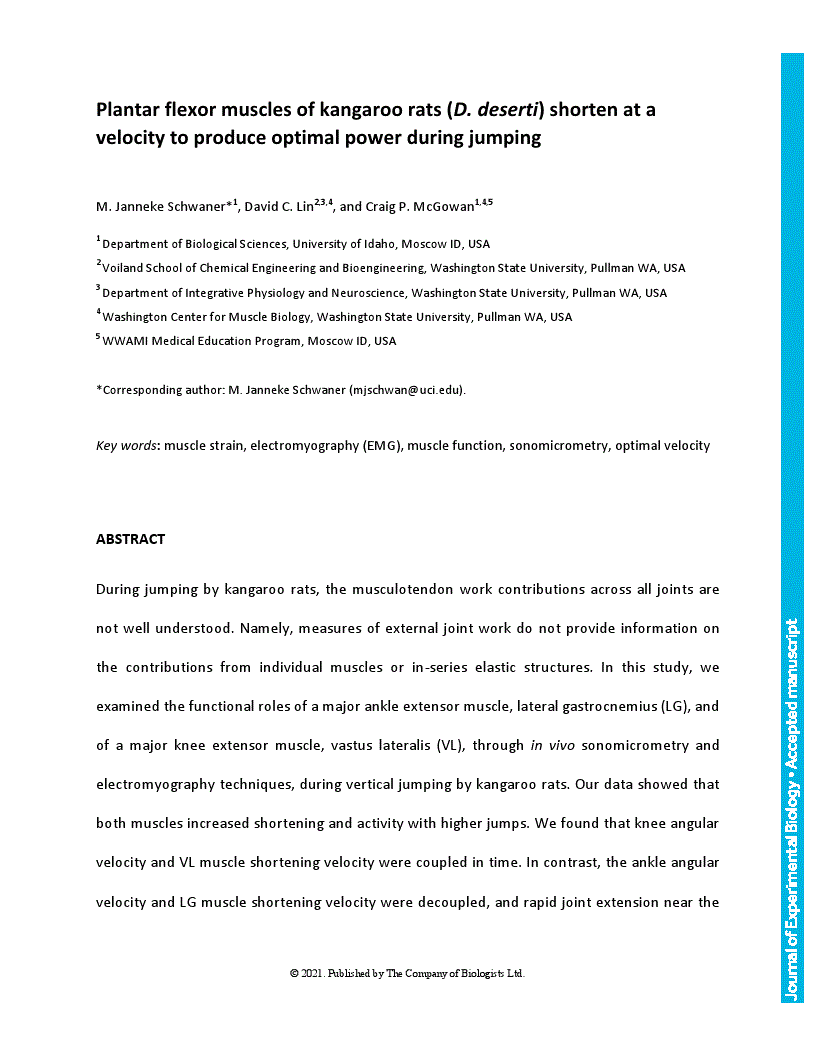During jumping by kangaroo rats, the musculotendon work contributions across all joints are not well understood. Namely, measures of external joint work do not provide information on the contributions from individual muscles or in-series elastic structures. In this study, we examined the functional roles of a major ankle extensor muscle, lateral gastrocnemius (LG), and of a major knee extensor muscle, vastus lateralis (VL), through in vivo sonomicrometry and electromyography techniques, during vertical jumping by kangaroo rats. Our data showed that both muscles increased shortening and activity with higher jumps. We found that knee angular velocity and VL muscle shortening velocity were coupled in time. In contrast, the ankle angular velocity and LG muscle shortening velocity were decoupled, and rapid joint extension near the end of the jump produced high power outputs at the ankle joint. Further, the decoupling of muscle and joint kinematics allowed the LG muscle to prolong the period of shortening velocity near optimal velocity (Vopt), which likely enabled the muscle to sustain maximal power generation. These observations were consistent with a LG tendon that is much more compliant than that of the VL.
Plantar flexor muscles of kangaroo rats (D. deserti) shorten at a velocity to produce optimal power during jumping
- Award Group:
- Funder(s): National Science Foundation
- Award Id(s): 1553550
- Funder(s):
- Award Group:
- Funder(s): Army Research Office
- Award Id(s): 66554-EG
- Funder(s):
Currently Viewing Accepted Manuscript - Newer Version Available
- Split-screen
- Views Icon Views
- Open the PDF for in another window
-
Article Versions Icon
Versions
- Version of Record 22 December 2021
- Accepted Manuscript 06 December 2021
- Share Icon Share
-
Tools Icon
Tools
- Search Site
M. Janneke Schwaner, David C. Lin, Craig P. McGowan; Plantar flexor muscles of kangaroo rats (D. deserti) shorten at a velocity to produce optimal power during jumping. J Exp Biol 2021; jeb.242630. doi: https://doi.org/10.1242/jeb.242630
Download citation file:
Advertisement
2023 JEB Outstanding Paper Prize shortlist and winner

The JEB Editors are delighted to announce the shortlisted authors for the 2023 JEB Outstanding Paper Prize. Read the winning paper - Tiny spies: mosquito antennae are sensitive sensors for eavesdropping on frog calls - by Hoover Pantoja-Sanchez and Brian Leavell from Ximena Bernal's lab at Purdue University, USA.
JEB Science Communication Workshop for ECRs

If you’re an early-career researcher interested in science communication and are attending the SEB Annual Conference in Prague this summer, come a day early and join the JEB Editors at a sci comm workshop to learn the key writing skills needed to promote your research to a broad audience beyond your peers (1 July at 14.30-17.30). Places are limited to 24 attendees, and applicants should apply through the SEB registration page by 30 April 2024.
Bridging the gap between controlled conditions and natural habitats in understanding behaviour

Novel technologies enable behavioural experiments with non-model species, in naturalistic habitats and with underexplored behaviours. In their Commentary, Scholz and colleagues discuss how to obtain a deeper understanding of the natural ecology and lifestyle of study animals.
Beluga metabolic measures could help save species

To help save animals from extinction, it’s important to understand what each species needs to survive. This led Jason John et al. to measure the metabolic rates of captive belugas to develop a ‘fish calculator’ showing that the whales need to eat ~23 salmon per day.
ECR Workshop on Positive Peer Review

Are you an ECR looking for tips on how to write concise, astute and useful manuscript reviews? If so, join the JEB Editors at a 2-hour JEB-sponsored Workshop on Positive Peer Review at the Canadian Society of Zoologists annual meeting in Moncton on 9 May 2024 at 13.00-15.00. There are 25 spaces for ECRs and selection is first come, first serve. To sign up, check the ECR Workshop box when you register for the CSZ meeting.



